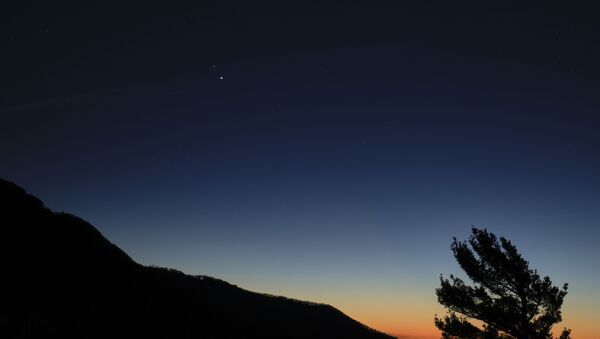As the planets Jupiter and Saturn make their historic “great conjunction” on Monday, amateur astronomers are snapping incredible photos of the two gas giants.
On Monday, the outer planets of Jupiter and Saturn will appear incredibly close together in the night sky - so close that, to the naked eye, they will seem to be a single bright star. While such a conjunction happens roughly every 20 years or so, the last time they appeared this close was more than 800 years ago.
In reality, the planets are not physically any closer to each other than they normally are; the conjunction is only possible for a viewer here on Earth, thanks to a perspective phenomenon called “parallax.”
As night falls around the world, astronomers are taking to their backyards and dark hilltops with their telescopes and cameras and snapping photos of the two planets so close together, each of which are also favorites for amateurs to spot.
Some quick #Conjunction shots tonight. @VirtualAstro @DavidBflower @StormHour Got some videos to process now! pic.twitter.com/RARGZM5qZ7
— Peter Lewis (@PeterLewis55) December 20, 2020
Jupiter, Saturn & visible moons (Callisto, Ganymede, Io, Europa + Titan) 20/12/20 As good a shot of the #GreatConjunction I'm likely to get in London. Tomorrow's forecast is not good. @StormHour @ThePhotoHour @DavidBflower @VirtualAstro #jupitersaturnconjunction Technical info 👇 pic.twitter.com/eQhUCmxdU4
— Peter Lewis (@PeterLewis55) December 20, 2020
The photos are made all the more stunning thanks to the incredible brightness of the giant planets’ largest moons, which hold an important place in the history of science. Jupiter’s four large moons Callisto, Europa, Ganymede and Io, all visible in the photos, were discovered by Italian physicist Galileo Galilei in 1610 - the first moons ever spotted by humans other than our own. Their discovery was a major blow to the geocentric theory, which proposed that the entire universe revolves around the Earth. Saturn’s huge moon Titan was spotted 45 years later by Dutch astronomer Christiaan Huygens.
View this post on Instagram
Europa and Titan are both candidates for possible extraterrestrial life, and NASA has proposed missions to both moons to find out.

